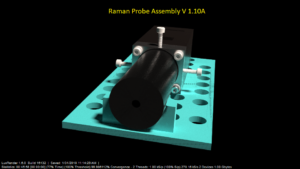3D Printed Raman Probe Allows You to Explore Scattered Light
3D printing has opened up avenues for so many innovators around the world, allowing for the creation of new parts, pieces, objects, and tools that otherwise may not have been accessible to a variety of designers, engineers, and makers full of ideas. Scientific tools are a great example of this too, as expense is normally such a factor in prohibiting most of the public from being able to use them to see the world in new ways and conduct a variety of experiments.
With the 3D printable raman probe, created by David H. Haffner, Sr., science enthusiasts can create one of the most important components of the raman spectroscope — a tool that allows us to find out more about the material makeup of materials, as one light color is illuminated and gives us information via light interaction with a sample. And with the benefits of 3D printing, makers today are able to enjoy the ability to create such items directly from their own workshops, whenever they want, and make edits at will. They can do so quickly, whether making actual parts for a project or creating rapid prototypes. Affordability is one of the greatest factors of all too, along with the opportunity to experiment with a wide range of materials.
Haffner created this new probe based on a previous project that allowed him to expand his knowledge and create a ‘radical new design concept’ with inspiration from Eduardo H. Montoya R., Aurelio Arbildo L., and Oscar R. Baltuano E., outlined in their paper, “A Homemade Cost Effective Raman Spectrometer with High Performance.”
As a detector, Haffner used a DSLR Nikon D3400 24.2MP Bluetooth camera with the following specifications:
- Effective Pixels (Megapixels) 24.2 million
- Sensor Size. 23.5 mm. x 15.6 mm
- Image Sensor Format. DX
- Storage Media. SD. SDHC
- Top Continuous Shooting Speed at full resolution, with five frames per second
- ISO Sensitivity – ISO 100 – 25,600.
- Movie – Full HD 1,920×1,080 / 60 fps.
- Three-inch monitor
Haffner also used a reflecting mirror, 1800 mm/gr diffraction grating holographic (as the spectrometer), and two fiber optic cables. Here you can find information regarding the probe assembly, laser collimation tube and assembly, along with the blueprints and build instructions. This 3D printed raman probe is still a work in progress, and Haffner is providing updates. Check out instructions for assembly here as well as reading about his more recent changes to the concave mirror, as he resolved several issues.
If you have continued interest in raman probes and spectroscopes, you can find out more here (downloading an entire booklet of information from the science technology experts at Renishaw), or read one of our previous articles about 3D printed components that also make raman spectroscopy more accessible.
What do you think of this news? Let us know your thoughts; join the discussion of this and other 3D printing topics at 3DPrintBoard.com.
[Source/Images: Hackaday]
Subscribe to Our Email Newsletter
Stay up-to-date on all the latest news from the 3D printing industry and receive information and offers from third party vendors.
You May Also Like
Simulation Complete: Pioneer Crew Wraps Up Year-Long Mission in 3D Printed Mars Habitat
After 378 days of living in a Mars-like 3D printed habitat, NASA’s Crew Health and Performance Exploration Analog (CHAPEA) crew emerged on July 6, 2024, bringing with them vital insights...
Alquist 3D Learns Some Lessons for the Construction 3D Printing Industry
The demolition of a home 3D printed by Alquist 3D spread like wildfire when it was reported last winter. While many took the opportunity to express their skepticism over additive...
Texas Cracks Down on Illegal Gun Switches, Including 3D Printed Ones
Texas has unveiled Operation Texas Kill Switch, a new initiative to target illegal machine gun-conversion devices, commonly known as “switches.” These tiny devices, often no bigger than an inch, can...
UK Utility Company Launches Hub for Wastewater “Printfrastructure”
With homebuilding serving as the primary marketing vehicle for additive construction (AC), we’re starting to see concrete 3D printing further drive its way into other areas of the architecture, engineering,...





































